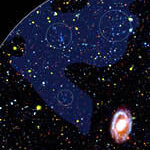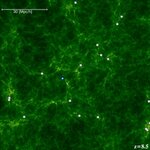Space
During the next decade, some cosmologists say a delicate measurement of primordial light could reveal evidence for the cosmic inflation hypothesis, which proposes that a random, microscopic density fluctuation in the fabric of space gave birth to the universe in a hot big bang approximately 13.7 billion years ago - it also predicts the existence of an infinite number of universes. The hypothesis was first proposed by Alan Guth of the Massachusetts Institute of Technology in 1979 but cosmologists currently have no way of testing this prediction.
But they can still try and find evidence…
My Satellite will either save or destroy the Earth. I work as a Daytime Astronomer on the STEREO mission, a pair of identical satellites sent into an Earth-sized solar orbit to stare at the Sun.
Apparently, we also kill satellites. Our PI-- Principal Investigator-- took the role of private investigator and forwarded a Russian newspaper article on the recent satellite collision. Unjustly, they took an artist's conception of our satellite and added in some debris and wreckage to implicate us in the collision!
Yes, that's one of our 2 STEREO satellites in the picture. However, I have it on good…

Gamma-ray bursts are the universe's most luminous explosions. Astronomers believe most occur when exotic massive stars run out of nuclear fuel. As a star's core collapses into a black hole, jets of material -- powered by processes not yet fully understood -- blast outward at nearly the speed of light. The jets bore all the way through the collapsing star and continue into space, where they interact with gas previously shed by the star and generate bright afterglows that fade with time.
NASA's Fermi Gamma-ray Space Telescope is an astrophysics and particle physics partnership mission,…

Evidence of star birth within a cloud of primordial gas has given astronomers a glimpse of a previously unknown mode of galaxy formation. The cloud, known as the Leo Ring, appears to lack the dark matter and heavy elements normally found in galaxies today. The unexpected discovery comes thanks to instruments aboard NASA’s Galaxy Evolution Explorer (GALEX) spacecraft which are sensitive to the ultraviolet radiation emitted by newly formed stars.
The team, led by astronomer David Thilker of Johns Hopkins University, included Barry Madore and Mark Seibert of the Carnegie Observatories. “This…

I often get the query "what is a good website for astronomy?". My instant answer is "Astronomy Picture of the Day". If you're only going to check one site, choose this. One picture plus a paragraph of text each day, that's it-- simple, elegant, informative, beautiful.
If APOD piques your interest, there are good sites to go deeper. "Imagine the Universe" is a useful resource site. Don't let that Imagine lists as 'for age 14 or older' dissuade you. It's a great "facts" site, especially the "Ask an Astrophysicist" section-- full of common questions and answers delivered at a 'high layman…
Just a little weekend tidbit, art from the science world. Sometimes, during talks, I'll see art where others see just a data or figure. Here are two cases from a recent conference that I love.
This one could be called "Relationship between a CME-driven shock and a coronal metric type II burst", excerpted, from Y. Liu. But I prefer to call it 'sunset on the sea':
If you click on the image, you can see the full data plot, taken (without forewarning to the scientists) from their online powerpoint slides.
This one is either "STEREO small ICME activity" by K.E.J. Huttunen, or "…

One of my readers (via Facebook) said he loved my blog but still had no idea what I did. Good point. While most career scientists hyperspecialize, I've moved among multiple fields of astronomy, often confusing myself in the process.
Currently, I create computer simulations of the sun to understand and enable prediction of the brief but potent solar eruptions that can kill cellphones, GPS and airline pilots. For those in the field, I say I study coronal mass ejections (CMEs) using data from the NASA STEREO satellites.
I prefer work in space weather-- how the sun influences…

Scientists have used a computer simulation to predict what the very early Universe would have appeared like 500 million years after the Big Bang. The images, produced by scientists at Durham University's Institute for Computational Cosmology, show the "Cosmic Dawn" - the formation of the first big galaxies in the Universe.
Universe 590 million years after the Big Bang. Credit:Alvaro Orsi, Institute for Computational Cosmology
The Cosmic Dawn began as galaxies began to form out of the debris of massive stars which died explosively shortly after the beginning of the Universe. The Durham…

The recent video "Barriers to Innovation" has some great thoughts about the culture of NASA and its barriers to innovation. Arriving from a Johnson Space Center study, the 10 minute video is worth a look.
Ultimately, yes, I wish NASA had more of a mad scientist component. I think they're risk averse because that's part of their mandate. Google's founders gave Google "do no evil". Congress gave NASA "don't screw up".
NASA takes innovation risks all the time-- but usually late in a mission or on small scales. The older the Mars rovers get, the more risky the missions they'll try. The…

I gave a talk on my dissertation work. Several of the more senior scientists were amazed at the bonafide science it contained. They'd had me pinned as someone who did 'service work'-- programming, project management, all the stuff that enables science for others (them). This is the kiss of death to scientific collaboration. Once you're marked with the taint of 'service', everyone assumes you're a scientific moron.
You can tell the difference in how they explain something. If you're a service person, they give you analogies ("imagine if..."). If they see…